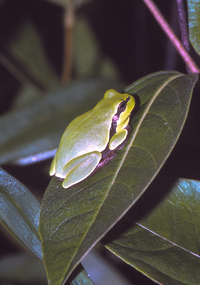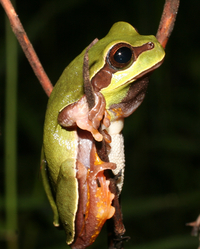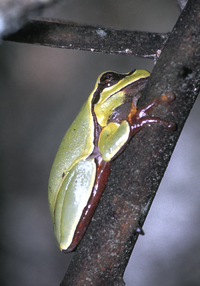Taxonomy
Class: AmphibiaOrder: AnuraFamily: HylidaeSubfamily: Hylinae
Taxonomic Comments: Duellman et al. (2016) elected to split treefrogs in the genus Hyla into two genera. Hyla (sensu stricto) refers to a group of species that are found in Eurasia, while a new genus Dryophytes was resurrected to include all of the North and Central American species and three other species that are found in eastern temperate Asia. Members of these proposed genera cannot be distinguished by any known morphological features, but represent two clades. Whether members of these clades should be placed in separate genera or treated as lesser taxa such as subgenera is arbitrary and dependent on one's taxonomic philosophy. Here, we retain Hyla for North American species to be consistent with current usage by the Society for the Study of Amphibians and Reptiles. Hyla andersonii that occur in New Jersey, the Carolinas, and Florida and Alabama. The mitochondrial markers showed little evidence of there being three well-differentiated groups, but faster-evolving microsatellite markers did. The acoustic and morphometric data showed much overlap between the three geographic groups. Collectively, the overlap in trait values between neighboring regions was sufficiently high that the authors recommended continuing to treat this taxon as a single species. Species Comments: Hyla andersonii was not named after an individual, but for a town (Anderson, South Carolina), where the first specimen was supposedly found. The species has never been observed in this part of South Carolina, but the first known specimens may have been shipped from Anderson. They most likely came from the Carolina Sandhills (Dodd 2013).
Identification
Description: The Pine Barrens Treefrog is a strikingly marked species that is readily identifiable by the contrasting green and purplish-brown coloration on the dorsum and sides. The dorsum of the head, back and legs are green and contrast with a prominent chocolate-brown to purplish band that passes laterally from the nostril through the eye to the hind limb. The band broadens posteriorly and is bordered by a narrow white to yellowish stripe that separates it from the green above (Beane et al. 2010, Dodd 2013). A narrow white stripe or fringe is also present around the eye and on the lower edges of the green coloration on the legs. Bright yellow-orange spots are present in the armpit and on the inside surfaces of the hind legs. These extend outward along the lower sides of the body for a short distance. The venter is white. The sexes are similar except that the chins and vocal sacs of the males are light purplish gray. H. femoralis (Dodd 2013, Means and Longden 1976). The tadpoles have inducible defenses against predatory dragonfly larvae and develop much darker tail coloration and deeper tail fins when exposed to caged dragonfly larvae (Kruger and Morin 2020). So, expect variation in patterning and tail fin morphology depending on local site conditions. Vocalizations: The advertisement call of the Pine Barrens Treefrog is very similar to that of the Green Treefrog. The call has been described in various ways (Dodd 2013, Noble and Noble 1923), but is perhaps best represented as a nasally "quank," “quack-ack,” or “aquack-aquack-aquack,” that is rapidly repeated 2-3 times per second. Individuals in Florida have a higher pitched voice than those in New Jersey (Means and Longden 1976). H. andersonii tends to be shorter and repeated at a faster rate; however, there is significant overlap among individual frogs. Certain technical components of the calls also differ. In particular, lower peak frequencies are higher in H. andersonii , while upper peak frequencies are lower relative to those of H. cinerea . In choice experiments, Gerhardt (1974) found that female H. cinerea were not attracted to the calls of H. andersonii , but female H. andersonii were attracted to the calls of male H. cinerea . Artificial crosses in the lab produced viable hatchlings (Gerhardt 1974). These species generally tend to sort out by habitat, with H. cinerea preferring more permanent habitats. As such, opportunities for hybridizing in the field are limited. The call is very loud and can be heard > 1 km away on quiet nights (Dodd 2013). Online Photos: Google iNaturalist Observation Methods: Adults are most easily observed during the breeding season when the males are calling.
Download Video:
"MP4"
Download Video:
"MP4"
AmphibiaWeb Account
Distribution in North Carolina
Distribution Comments: The Pine Barrens Treefrog has an unusual relictual geographic distribution. Three widely separated groups have been discovered that occur in central and southern New Jersey, the Carolina Sandhills of North and South Carolina and the coastal regions of southeastern North Carolina, and the Florida Panhandle and adjacent areas of extreme southern Alabama (Moler 1981). Neill (1947) reported that he collected a specimen from Richmond County, Georgia, but attempts to relocate this population have failed and Jensen et al. (2008) questioned the validity of this record.Distribution Reference: Dodd (2013)County Map: Clicking on a county returns the records for the species in that county.
GBIF Global Distribution
Key Habitat Requirements
Habitat: Hyla andersonii has rather specialized habitat requirements. It is generally associated with pocosins, acid bogs, shrub bogs, and seepage areas that are surrounded by sandy habitats and have clear, shallow, and often slow moving water (Dodd 2013, Moler 1981). Sites in Florida and the Carolinas are often dominated by shrubs and small trees such as titi (Cliftonia spp.), Large Gallberry (Ilex coriacea ), Sweetbay Magnolia (Magnolia virginiana ), Coastal Sweet-pepperbush (Clethra alnifolia ), and Sparkleberry (Vaccinium arboretum ), and often have extensive areas of Sphagnum moss and acidophilus herbs. The adjacent habitats typically are sandhills or sometimes mixed pine-hardwood forests. In South Carolina, local populations have been found in power-line and gas-line rights-of-ways and in recent clearcuts where pools are present and tree clearing promotes a shrubby undergrowth (Tardell et al. 1981). In New Jersey, the species occurs in the Pine Barrens around small sphagnaceous white cedar or cranberry bogs, in seepage areas along tributaries of streams, and occasionally at disturbed sites such as roadside ditches and pools in powerline corridors where shrubs and grasses prevail. The breeding sites are surrounded by uplands that are dominated by pitch pines (McCormick 1970). H. andersonii is associated with acidic Sandhill Seeps and seepage bogs in the Inner Coastal Plain (Fall-line Sandhills) and with small, frequently burned peatlands in the Outer Coastal Plain. The presence of fish-free pools are critical for breeding and larval development and occur mainly in peatlands that are burned frequently enough to limit the growth of tree species (Means and Moler 1979). Small, fish-free, blackwater beaver ponds with peatland plant species growing around their margins are also used for reproduction. Adults can be found both in the shrubby and herbaceous zones that are typical of these small, frequently burned peatlands. These conditions are particularly evident in the Fall-line Sandhills, where the largest populations of this species occur in North Carolina. Environmental and Physiological Tolerances: This species commonly breeds in acidic, nutrient-poor waters. The eggs can tolerate a pH of 3.7-3.8, which is well below the pH values of natural ponds (Freda and Dunson 1986, Gosner and Black 1957a). In one study, low pH adversely affected the growth rates of larvae, with larvae growing 40% slower at pH 3.75 relative to a higher pH (Freda and Dunson 1986). However, Pehek (1995) grew larvae in cattle tanks with two experimental pHs and found that low pH (3.9) has no effect on the survival, body mass, length of the larval period, or growth of larvae. In general, this species appears to be well-adapted to acidic breeding sites. The adults produce a layer of mucous and lipids on the skin surface that help retard water loss (Barbeau and Lillywhite 2005). Adaptations to Natural Disturbances: The Pine Barrens Treefrog is strongly associated with fire-maintained habitats. Except during prolonged droughts, fires rarely penetrate into the centers of the peatland habitats occupied by this species. Adults can probably also survive burns by sheltering within pools or seepage trickles located within the center of these peatlands.Biotic Relationships: The adults almost always breed in fish-free habitats and appear to lack chemical defenses against fish. The tadpoles are quickly eliminated from experimental pond communities that contain predatory sunfish (Kurzava and Morin 1998, Pehek 1995), and presumably are palatable to a variety of invertebrate predators. Larval odonates commonly co-occur in ponds with H. andersonii and feed upon the tadpoles. The young tadpoles have inducible defenses and develop much darker tail coloration and deeper tail fins when exposed to caged dragonfly larvae (Kruger and Morin 2020). The darker, wider tails presumably direct attacks away from the head and body and facilitate the ability of tadpoles to tear away from a predator's grasp. The ripped tails can then be regrown.H. andersonii emits an odor that resembles that of raw peas. It is possible that the chemicals that are secreted on the skin have an anti-predator function (Dodd 2013). The body coloration and patterning may function as disruptive coloration and help individuals blend into green foliage. The natural predators of the juveniles and adults are unknown.
Life History and Autecology
Breeding and Courtship: The males begin calling after the spring warm-up and continue through late summer. Calling occurs in Florida from March to September, typically in association with high humidity and precipitation (Dodd 2013, Means and Longden 1976, Moler 1981). Males in the Carolinas call from April to September (Beane et al. 2010, Cely and Sorro 1986). In New Jersey, calling begins in May and continues to August (Davis 1907, Noble and Noble 1923, Wright 1932). Reproductive Mode: Once amplexed, the females moves to shallow water to lay their eggs. A female initiates oviposition by bowing her back and thrusting her legs laterally. This stimulates the male to move his legs to her sides in a stroking manner, whereupon she extrudes 7-14 eggs and the male fertilizes them (Dodd 2013, Noble and Noble 1923). The eggs are laid singly and fall directly through the water onto the substrate.Aquatic Life History: Relatively little is known about the larval ecology. The larvae do not strongly swim through the water column or school. Noble and Noble (1923) observed large numbers of them resting motionless with the dorsal fin nearly touching the water surface, then diving quickly into cover when approached. Aquatic predators undoubtedly take their toll, and larvae will reduce their activity and become more benthic when held in tanks with newts, fish, or odonates (Lawler 1989). Most larvae appear to metamorphose within 2-3 months and the froglets are typically 11–15 mm SUL. Tadpoles that were raised in outdoor tanks by Kruger and Morin (2020) metamorphosed in 41-166 days, with 73% metamorphosing within 70 days. The larval period lasted 49–75 days in other reared animals (Gosner and Black 1957b, Wright 1932). Terrestrial Life History: The young metamorphs grow rapidly and can become sexually mature by the first summer following metamorphosis if they are derived from eggs that hatched early in the season (Dodd 2013). Those that metamorphose relatively late in the year may require another year of growth and may not breed until the spring of their second year.
General Ecology
Population Ecology: Local populations are often small (e.g., Sorrow 1982), which reflects the small size of many seepages and bog ponds that are used as breeding sites. Moler (1981) noted that fewer than a dozen males can be heard calling on a given night at most Florida sites, but this undoubtedly underestimates the total population sizes. Because this species calls erratically, Moler et al. (2020) recommended a minimum of five site visits before inferring that the species is absent. The extent to which populations are organized as metapopulations is unknown. Community Ecology: The Pine Barrens Treefrog often shares breeding ponds with other anurans, as well as crayfishes, aquatic insects, and on very rare occasion fishes and newts. Most of our understanding of interactions involving competitive and predatory interactions with community members are based on studies in laboratory aquaria or outdoor tanks. The results suggest that H. andersonii tadpoles can potentially compete with other aquatic organisms, including herbivorous insects and other anuran larvae (Morin et al. 1990, Pehek 1995). The timing of reproduction also may influence the outcome of competition between H. andersonii larvae, aquatic insects, and other anurans. H. andersonii is so acid tolerant that it can exploit acidic habitats that other species cannot tolerate. However, Pehek (1995) found that low pH had no effect on the competitive ability of larval H. andersonii when raised experimentally with larval Lithobates sphenocephalus or H. versicolor . Competition with L. sphenocephalus reduced survival and body mass at metamorphosis of larval H. andersonii , whereas competition with larval H. versicolor only reduced body mass. In another experiment, the presence of insects and toad larvae (Anaxyrus fowleri ) decreased the mean mass of H. andersonii at metamorphosis, but did not affect survivorship or the length of the larval period (Morin et al. 1988). Additional studies are need to determine the extent to which these results apply to natural communities.
Adverse Environmental Impacts
Status in North Carolina
NHP State Rank: S2Global Rank: G4Status in North Carolina: TPopulations: Local populations of H. andersonii in North Carolina are small, with most probably consisting of < 100-200 adults. Many appear to be isolated from their nearest neighbors, with no connectivity via dispersal between ponds. Small, isolated populations have higher risks of local extinction, which is a major concern for the remaining populations within the state. Oswald et al. (2020) found that populations in North Carolina have relatively high genetic diversity and were probably the historical source for disjunct populations in Florida/Alabama and New Jersey. Data from both Warwick et al. (2015) and Oswald et al. (2020) indicate that the NC-SC geographic isolate contains two genetic clusters, with those in North Carolina constituting a separate group. Environmental Threats: The Pine Barrens Treefrog appears to have declined precipitously in many locations during the last few decades, including at many sites in North Carolina. Warwick et al. (2015) noted that populations no longer exist in many locations where historical records over the last thirty years indicate they were present. They revisited numerous sites in North Carolina and South Carolina with documented museum records and detected this species in only 5 of 29 counties with known historical records. Habitat loss, fire suppression, and the spread of feral hog populations that degrade habitats have likely all contributed to the decline (Engeman et al. 2007, Means and Moler 1979, Oswald et al. 2020). Fire suppression allows the encroachment of woody, canopy vegetation which acts to degrade or eliminate the preferred seepage bogs or shrub bog habitats (Means and Longden 1976, Moler et al. 2020). The breeding sites are also sensitive to surrounding land management activities and are easily degraded or destroyed by activities that alter natural hydrologic regimes, including groundwater withdrawals (Bunnell and Ciraolo 2010). Status Comments: H. andersonii is an IUCN Red List near-threatened species and is considered to be at risk of decline because of habitat loss (IUCN 2016). It is also listed as imperiled in Florida, threatened in New Jersey, threatened in North Carolina, and a species in need of management in South Carolina (Bennett and Buhlmann 2015). Stewardship: Fire suppression that allows the encroachment of trees into the breeding sites is the greatest issue regarding management. Prescribed burns are critical in many areas for sustaining local populations.

 »
»







